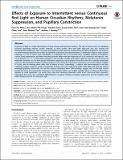| dc.contributor.author | Ho Mien, Ivan | en_US |
| dc.contributor.author | Chua, Eric Chern-Pin | en_US |
| dc.contributor.author | Lau, Pauline | en_US |
| dc.contributor.author | Tan, Luuan-Chin | en_US |
| dc.contributor.author | Lee, Ivan Tian-Guang | en_US |
| dc.contributor.author | Yeo, Sing-Chen | en_US |
| dc.contributor.author | Tan, Sara Shuhui | en_US |
| dc.contributor.author | Gooley, Joshua J. | en_US |
| dc.date.accessioned | 2014-07-07T18:15:10Z | |
| dc.date.issued | 2014 | en_US |
| dc.identifier.citation | Ho Mien, Ivan, Eric Chern-Pin Chua, Pauline Lau, Luuan-Chin Tan, Ivan Tian-Guang Lee, Sing-Chen Yeo, Sara Shuhui Tan, and Joshua J. Gooley. 2014. “Effects of Exposure to Intermittent versus Continuous Red Light on Human Circadian Rhythms, Melatonin Suppression, and Pupillary Constriction.” PLoS ONE 9 (5): e96532. doi:10.1371/journal.pone.0096532. http://dx.doi.org/10.1371/journal.pone.0096532. | en |
| dc.identifier.issn | 1932-6203 | en |
| dc.identifier.uri | http://nrs.harvard.edu/urn-3:HUL.InstRepos:12407038 | |
| dc.description.abstract | Exposure to light is a major determinant of sleep timing and hormonal rhythms. The role of retinal cones in regulating circadian physiology remains unclear, however, as most studies have used light exposures that also activate the photopigment melanopsin. Here, we tested the hypothesis that exposure to alternating red light and darkness can enhance circadian resetting responses in humans by repeatedly activating cone photoreceptors. In a between-subjects study, healthy volunteers (n = 24, 21–28 yr) lived individually in a laboratory for 6 consecutive days. Circadian rhythms of melatonin, cortisol, body temperature, and heart rate were assessed before and after exposure to 6 h of continuous red light (631 nm, 13 log photons cm−2 s−1), intermittent red light (1 min on/off), or bright white light (2,500 lux) near the onset of nocturnal melatonin secretion (n = 8 in each group). Melatonin suppression and pupillary constriction were also assessed during light exposure. We found that circadian resetting responses were similar for exposure to continuous versus intermittent red light (P = 0.69), with an average phase delay shift of almost an hour. Surprisingly, 2 subjects who were exposed to red light exhibited circadian responses similar in magnitude to those who were exposed to bright white light. Red light also elicited prolonged pupillary constriction, but did not suppress melatonin levels. These findings suggest that, for red light stimuli outside the range of sensitivity for melanopsin, cone photoreceptors can mediate circadian phase resetting of physiologic rhythms in some individuals. Our results also show that sensitivity thresholds differ across non-visual light responses, suggesting that cones may contribute differentially to circadian resetting, melatonin suppression, and the pupillary light reflex during exposure to continuous light. | en |
| dc.language.iso | en_US | en |
| dc.publisher | Public Library of Science | en |
| dc.relation.isversionof | doi:10.1371/journal.pone.0096532 | en |
| dc.relation.hasversion | http://www.ncbi.nlm.nih.gov/pmc/articles/PMC4010506/pdf/ | en |
| dash.license | LAA | en_US |
| dc.subject | Biology and Life Sciences | en |
| dc.subject | Biochemistry | en |
| dc.subject | Neurochemistry | en |
| dc.subject | Neuroendocrinology | en |
| dc.subject | Chronobiology | en |
| dc.subject | Neuroscience | en |
| dc.subject | Behavioral Neuroscience | en |
| dc.subject | Physiology | en |
| dc.subject | Physiological Processes | en |
| dc.subject | Medicine and Health Sciences | en |
| dc.subject | Endocrinology | en |
| dc.title | Effects of Exposure to Intermittent versus Continuous Red Light on Human Circadian Rhythms, Melatonin Suppression, and Pupillary Constriction | en |
| dc.type | Journal Article | en_US |
| dc.description.version | Version of Record | en |
| dc.relation.journal | PLoS ONE | en |
| dash.depositing.author | Gooley, Joshua J. | en_US |
| dc.date.available | 2014-07-07T18:15:10Z | |
| dc.identifier.doi | 10.1371/journal.pone.0096532 | * |
| dash.authorsordered | false | |
| dash.contributor.affiliated | Gooley, Joshua James | |


